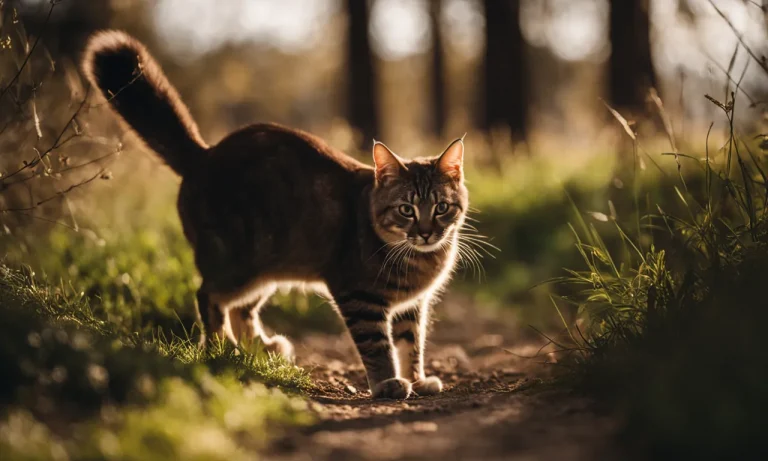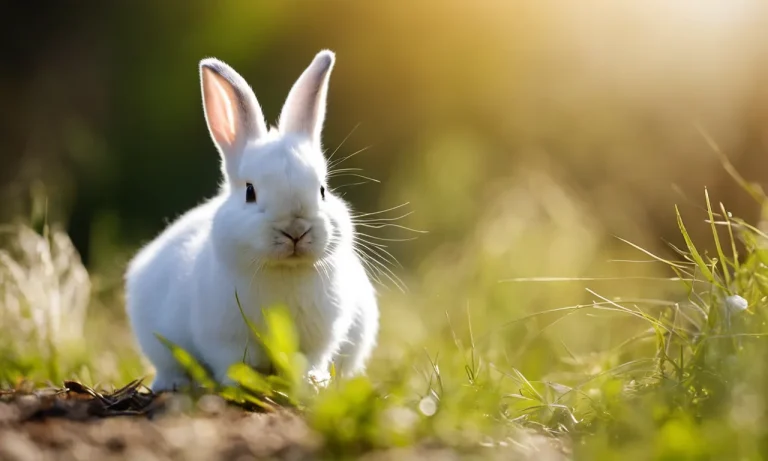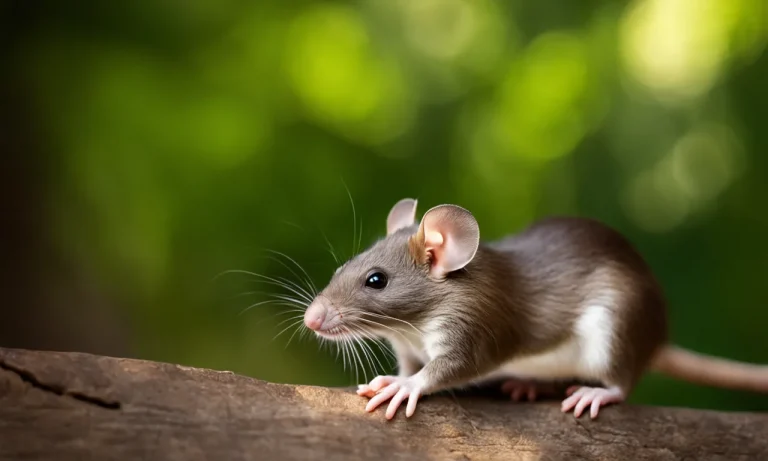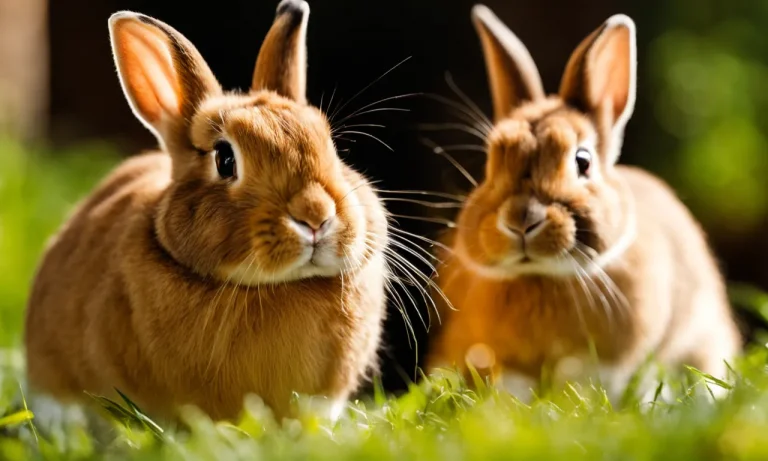Finding a nest of baby bunnies in your yard can be a magical experience. Their tiny noses and fuzzy fur make them unbearably cute. But what should you do if the nest is in a precarious location, like a frequently mowed area of your lawn?
You may be tempted to move the bunnies to a safer spot, but is disturbing a baby bunny nest ever ok?
If you’re short on time, here’s a quick answer to your question: While you should avoid moving wild baby bunnies whenever possible, there are some situations where relocating a nest is necessary for the bunnies’ safety.
Handle bunnies as little as possible, reunite them with their mother, and only move nests short distances to limit abandonment.
In this detailed guide, we’ll cover everything you need to know about moving baby bunnies. You’ll learn how to identify bunny nests, when it’s absolutely necessary to relocate a litter, the proper techniques for moving bunnies, how to reunite bunnies with their mother, the risks of abandonment, and what to do if the mother doesn’t return.
How To Identify a Baby Bunny Nest
Identifying a baby bunny nest can be a bit tricky, as these nests are often well-hidden to protect the young ones from predators. However, there are a few key indicators that can help you locate a baby bunny nest in your yard or garden.
Look for Shallow Depressions
Baby bunnies, also known as kits, typically build their nests in shallow depressions in the ground. These depressions are usually lined with grass, fur, or other soft materials to provide insulation and comfort for the newborns. Keep an eye out for small, shallow indentations in your yard or garden.
Search Areas Near Cover
Baby bunnies prefer to build their nests in areas that provide cover and protection. This can include areas near shrubs, bushes, or tall grass. These spots offer camouflage and help keep the nest hidden from potential threats.
So, if you notice any suspicious activity or movement near these areas, it might be a sign of a baby bunny nest nearby.
Notice Lined Fur Nests
Another telltale sign of a baby bunny nest is a lining of fur. Mother rabbits often pluck fur from their own bodies to create a soft and warm nest for their young ones. So, if you come across a nest that has a lining of fur, it is highly likely that it belongs to baby bunnies.
Take care not to disturb the nest, as the mother rabbit may abandon it if she senses danger.
It is important to note that if you do find a baby bunny nest, it is best to leave it undisturbed. Mother rabbits only return to the nest a few times a day to feed their young ones, and handling the nest or moving the babies can cause more harm than good.
If you have concerns about the nest’s location or safety, it is recommended to contact a local wildlife rehabilitation center for guidance and assistance.
When You Should (and Should Not) Move Baby Bunnies
Acceptable Reasons to Move a Nest
While it is generally best to avoid moving baby bunnies if possible, there are certain situations where it may be necessary. One acceptable reason to move a nest is if you accidentally stumble upon it while gardening or doing yard work.
In this case, it is important to carefully relocate the nest to a safe and quiet location nearby. When moving the nest, be sure to wear gloves to minimize the transfer of human scent, as this can potentially attract predators.
Another acceptable reason to move baby bunnies is if the nest is in an unsafe or unsuitable location. This could include areas with heavy foot traffic, exposure to extreme weather conditions, or the presence of predators.
If you notice that the nest is in immediate danger, such as being in the path of a lawnmower or near a busy road, it is crucial to intervene and move the bunnies to a safer spot.
When moving baby bunnies for acceptable reasons, it is important to keep in mind that their chances of survival are highest when they are left undisturbed. Therefore, it is best to minimize handling and disturbance as much as possible.
Situations When Moving Bunnies is Ill-Advised
While there may be instances where moving baby bunnies is necessary, there are also situations where it is ill-advised. One such situation is if the mother rabbit is still actively caring for the babies.
Mother rabbits only visit the nest a few times a day to nurse their young, and they intentionally keep their distance to avoid attracting predators. If you intervene and move the babies unnecessarily, it can disrupt the mother’s caregiving routine and potentially harm the bunnies.
It is also important to note that baby bunnies are highly sensitive to stress. Moving them unnecessarily can cause unnecessary stress and potentially lead to health problems or even death. Unless there is a clear and immediate threat to the bunnies’ safety, it is best to leave them undisturbed and let nature take its course.
How to Move Baby Bunnies
Minimize Handling of Bunnies
When it comes to moving baby bunnies, it is important to minimize their handling as much as possible. Baby bunnies are delicate creatures, and excessive handling can cause them stress and harm. It is best to avoid touching them unless absolutely necessary.
This is because the scent of humans on their bodies can attract predators, putting the bunnies at risk.
However, if you find yourself in a situation where you must handle the baby bunnies, make sure to do so with extreme care. Use gentle and slow movements, and always support their bodies properly. Avoid picking them up by their ears or limbs, as this can cause serious injury.
Keep the Bunnies Together
Another important aspect of moving baby bunnies is to keep them together. Bunnies are social animals and rely on each other for warmth and comfort. Separating them can lead to stress and can even result in the death of the bunnies, especially if they are too young.
When moving the baby bunnies, make sure to keep them in their nest or enclosure and avoid separating them from their siblings. This will help to minimize their stress levels and ensure their well-being during the moving process.
Move Nests Short Distances
When it comes to moving the nest of baby bunnies, it is best to do so in short distances. Bunnies are highly sensitive to changes in their environment, and moving them over long distances can be extremely stressful for them.
If you need to move the nest, try to find a location nearby that is suitable for the bunnies. This can be a quiet and secure area where they can continue to receive warmth and protection. Place the nest carefully in the new location, making sure to keep it intact and undisturbed.
It is important to note that if you find a nest of baby bunnies and need to move them, it is best to consult with a wildlife professional or a veterinarian who specializes in rabbits. They will be able to provide you with specific guidance and ensure the safety and well-being of the baby bunnies.
Moving baby bunnies requires caution and consideration for their well-being. By minimizing handling, keeping them together, and moving nests short distances, you can help ensure a smooth and stress-free transition for these adorable little creatures.
Reuniting Bunnies with Their Mother
It is not uncommon to come across baby bunnies in your yard or garden. If you find baby bunnies without their mother, you may be wondering what to do. The first instinct for many people is to move the babies to a safer location.
However, it is important to understand the best course of action to ensure the well-being of the baby bunnies. Reuniting them with their mother is often the best solution.
Leave the Area Quickly
When you stumble upon a nest of baby bunnies, it’s crucial to resist the urge to touch or move them immediately. Mother rabbits tend to leave their young ones alone for most of the day, only returning occasionally to feed them.
By staying away, you allow the mother to feel safe and return to her babies undisturbed.
It’s important to note that rabbits have a keen sense of smell and can detect human scent on their babies. This scent can make the mother bunny wary and lead her to abandon the nest. So, if you do happen to touch the baby bunnies, don’t panic.
You can take a small handful of grass and rub it on your hands to help mask your scent before leaving the area.
Check Back for Signs of Abandonment
After leaving the area, keep a close eye on the nest from a distance. Observe whether the mother bunny returns to care for her babies. Mother rabbits typically visit the nest early in the morning or late at night to avoid drawing attention to the area.
If you notice signs of abandonment such as hungry, crying baby bunnies or a nest that hasn’t been disturbed for more than 24 hours, it may be time to intervene. In such cases, it is advisable to contact a local wildlife rehabilitation center or a veterinarian who specializes in wildlife care.
They can provide guidance on the best course of action to ensure the well-being of the baby bunnies.
Remember, it is always best to let nature take its course whenever possible. Mother rabbits are equipped with the instincts to care for their young, and interfering with this natural process should be a last resort.
By following these guidelines, you can increase the chances of reuniting baby bunnies with their mother and giving them the best chance at survival.
Risks of Bunny Nest Abandonment
Causes of Abandonment
There are several reasons why a bunny nest might be abandoned by the mother. One common cause is disturbance or interference by humans or predators. Mother rabbits are very sensitive to any perceived threats to their nest, and if they sense danger, they may choose to abandon the nest to protect themselves.
Another cause of abandonment can be stress or illness in the mother rabbit. If she is not feeling well or is experiencing extreme stress, she may become unable to care for her young and may abandon the nest as a result.
It’s also important to note that some rabbit mothers may abandon their nests if they feel it is not a safe or suitable environment for their babies. This can happen if the nest is exposed to too much sunlight, extreme temperatures, or if it becomes flooded with water.
Signs of an Abandoned Nest
It is crucial to be able to identify signs of an abandoned bunny nest to determine if intervention is necessary. One common sign is the absence of the mother rabbit for an extended period. If you observe that the mother has not returned to the nest for more than 24 hours, it could indicate abandonment.
Another sign to look for is the lack of warmth in the nest. Mother rabbits keep their babies warm by covering them with fur and nesting material. If the nest feels cold to the touch, it could be a sign that the mother is no longer caring for the babies.
Additionally, if you notice that the babies are crying or appear weak and malnourished, this could also indicate that they have been abandoned and are in need of assistance.
Caring for Orphaned Bunnies
If you have determined that the bunny nest has been abandoned and the babies are in need of care, it is important to take appropriate steps to ensure their survival. First and foremost, it is crucial to keep the babies warm.
You can do this by providing a heating pad or a warm water bottle wrapped in a towel to mimic the warmth of the mother’s body.
Feeding the orphaned bunnies is another vital aspect of their care. It is recommended to consult with a veterinarian or a wildlife rehabilitator for guidance on the appropriate formula and feeding schedule for the babies. Proper nutrition is essential for their growth and development.
Lastly, creating a suitable and safe environment for the orphaned bunnies is crucial. This includes providing a comfortable nesting area, ensuring they have appropriate bedding material, and protecting them from predators.
For more information on caring for orphaned bunnies, you can visit www.wildlife.ca.gov.
When to Get Help for Baby Bunnies
Baby bunnies, also known as kits, are adorable creatures that often capture our hearts. However, it is important to know when to seek help for them and when to leave them be. In some cases, it may be necessary to contact wildlife rehabilitators who can provide the proper care and expertise needed to ensure the survival and well-being of these fragile creatures.
Contact Wildlife Rehabilitators
If you come across baby bunnies that appear to be injured, orphaned, or in distress, it is best to contact a wildlife rehabilitator. These professionals are trained to provide the necessary care and rehabilitation for wildlife, including baby bunnies.
They have the knowledge and resources to ensure the best possible outcome for these vulnerable animals.
Wildlife rehabilitators can be found in your local area by searching online or contacting your local animal control or wildlife conservation organization. They will be able to guide you on the next steps to take and may even be able to offer assistance in rescuing the baby bunnies.
Signs Bunnies Need Rescue
While it is natural for mother rabbits to leave their babies alone for extended periods of time, there are certain signs that may indicate the need for rescue. If you notice any of the following, it is important to reach out to a wildlife rehabilitator:
- The baby bunnies are visibly injured or bleeding.
- They are cold to the touch.
- They are not moving or responding when touched.
- They are constantly crying or making distress calls.
- They are covered in flies or maggots.
- Their nest has been destroyed or disturbed.
It is crucial to remember that well-meaning individuals may unintentionally cause harm to baby bunnies by attempting to care for them without the proper knowledge and resources. Therefore, it is always best to seek the help of professionals who can provide the appropriate care and ensure the best chance of survival for these delicate creatures.
For more information on wildlife rehabilitation and how to locate a wildlife rehabilitator in your area, you can visit www.wildliferehabber.org.
Conclusion
Finding a nest of wild baby bunnies comes with a lot of responsibility. While your instinct may be to help these tiny creatures, moving bunnies can do more harm than good if not done properly. With the right approach, you can relocate bunnies when absolutely necessary without jeopardizing the litter.
The most important things to remember are: minimize handling of bunnies, keep the nest intact, move it a short distance, and give the mother ample opportunity to reconnect with her babies. With this gentle approach, you’ll give the bunnies their best chance to grow up healthy in the wild.






